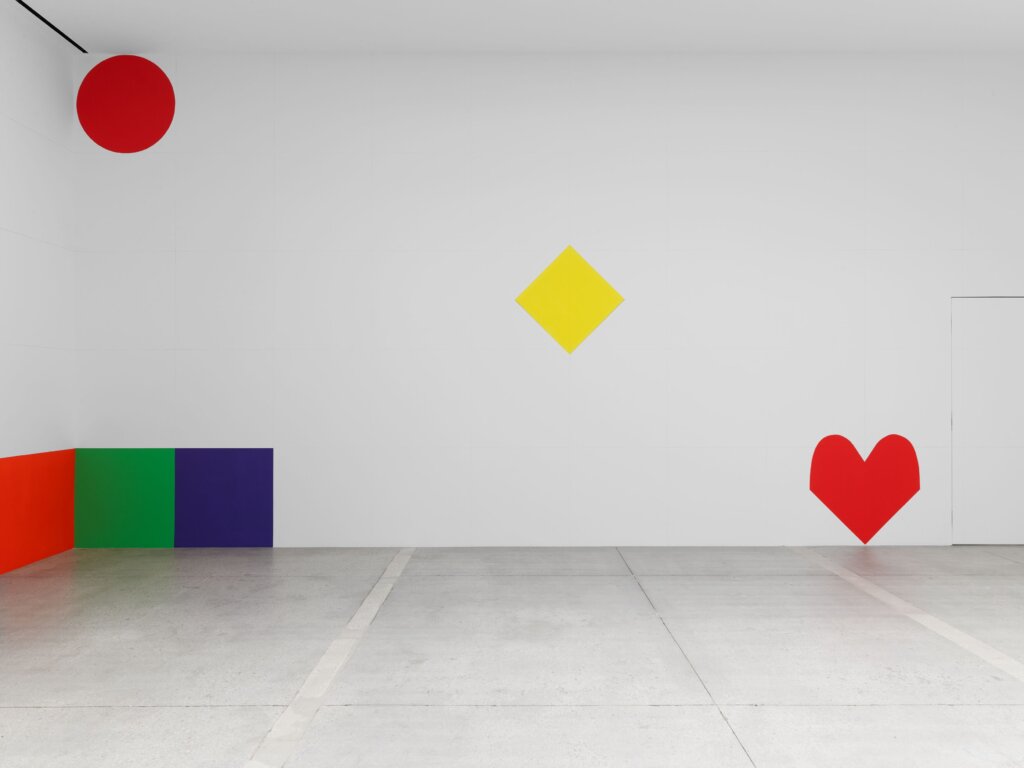
Pat Steir, “Mirage 1975” (Installation View), Hauser & Wirth, 2025. Photography by Sarah Muehlbauer. Image courtesy of the artist and Hauser & Wirth.
Pat Steir
Hauser & Wirth | 134 Wooster Street
Through August 15, 2025
Before her awesome curtains of dripping color, the famous canvases that, with the aid of gravity and various chemical reactions, “painted themselves,” there was the sharp conceptualism of Pat Steir’s in-situ works. “Mirage 1975,” in the former truck garage of Hauser & Wirth’s Soho location, restages the artist’s first-ever installation (at the State University of New York in Oneonta) for the occasion of both that show’s 50th anniversary and this summer’s publication of the lush doorstop Pat Steir Paintings 2018–2025—impressive evidence that the artist has kept very busy in her eighth decade. The handsome monograph and the terse, hard-edge (mostly) primary-color statement of the historical exhibition together stylishly bookend a tremendous career.
On the back wall, a red circle occupies the upper-left corner, and a blue square fills the upper-right. A yellow diamond (a rotated square) floats in the middle of the white expanse, and a red heart symbol, its curves partially shaved off to form a right-angle point at the bottom, touches the floor. This last, misfit shape tempers the abstract austerity of the artist’s exercise in geometric bounds-testing with a dash of humor, a gesture of Pop irony that lends the installation’s other scattered circles and squares a sense of mischief. There’s another oddball, a flower, up high on the left wall, first in a line of four shapes filled in with scribbly graphite, appearing like the answer to an elevated game of one-of-these-things-is-not-like-the-other. Here, Steir seems to ask something fundamental about abstraction vs. imagery—or she warns us (and herself) how easily it is to tip into an act of depiction when taking up the brush. The playfully stark installation seems an apt philosophical warm-up for an artist who would go on to pursue the egoless, aleatory possibilities of paint making paintings, with the artist there only to facilitate its start.—Johanna Fateman
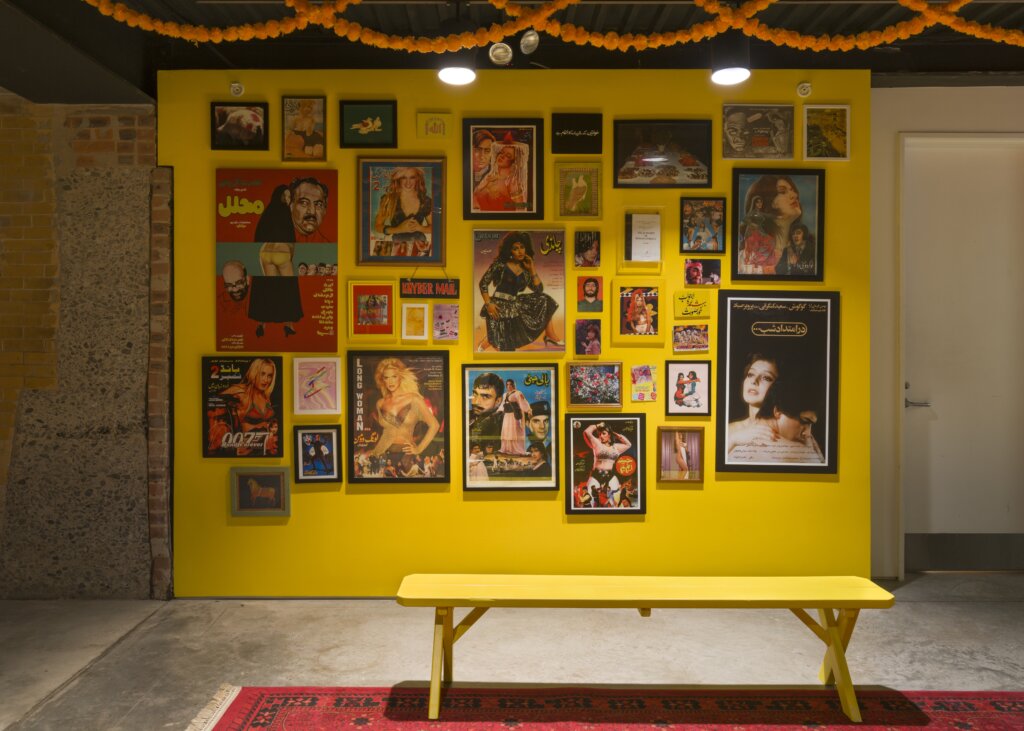
“Spasial Program by Khajistan”
SculptureCenter | 44-19 Purves Street, Long Island City
Through July 28, 2025
A flyer for Lahore’s preeminent pigeon-racing championship, replete with owner names and blood lines; devotional Shia tapestries sourced from Tehran’s Grand Bazaar; a Pakistani Urdu poster for an imaginary film featuring bubble-letter catchphrases like “Love will never die!” and the face of TV star Veena Malik somewhat crudely pasted onto the body of a foreign model; framed prints of horny memes pulled from Grindr and WhatsApp (“I love old man bottom uncle 50+”)—these are just a few of the items on display at Khajistan’s “Spasial Program,” an exhibition teeming with rare, illicit, suppressed, or otherwise neglected digital and physical media artifacts that span the entire Islamicate world.
The brainchild of Lahore-born filmmaker Saad Khan, and a product of years of assiduous compilation, Khajistan is an archive, a state of mind, a repeatedly banned Instagram account, and a tangible, sometimes-cheeky counter to our present moment of historical amnesia. Stored inside SculptureCenter’s twisting basement gallery, “Spasial Program” emerges as a contemporary “Toshakhana” (or dazzling “treasure house”), which also happens to be the name of Khajistan’s always-growing physical archive. As I made my way along the exhibition’s narrow, rug-adorned halls, moving past scores of Lollywood posters, war propaganda leaflets, satirical cartoons, and bulbous video monitors playing porn ripped from VCDs, the uniquely anarchic splendor of the archive began to take hold. With every piece of ephemera placed on the same plane, no matter its context—whatever time period, political sensibility, religious perspective, or technological era it represents—“Spasial Program” feels like a story told in medias res, already in motion, waiting for you, the viewer, to make your own way through its riches.—Will Harrison
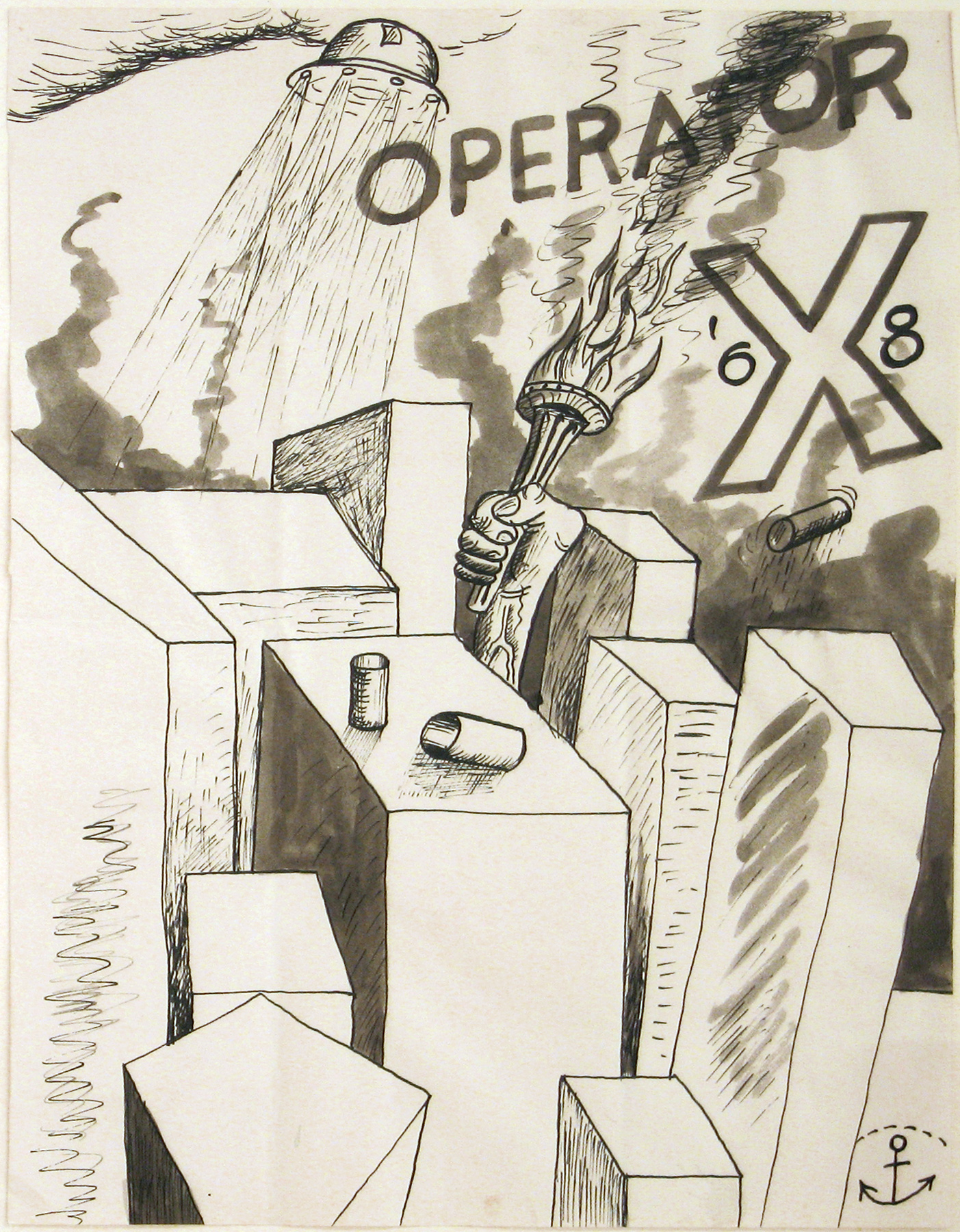
H.C. Westermann
Theodore Gallery | 373 Broadway, 6th floor, #F10
Through August 1, 2025
H.C. Westermann (1922–1981) has super fans who delight in going deep into the most minor aspects of his work. But you needn’t be a devoted acolyte (I’m not) to appreciate the letters, drawings, and prints gathered at Theodore. Previously, Westermann was best known to me for his sculptures that distill folk aesthetics into refined yet mysterious objects, marrying Americana with elements of Pop and Surrealism. But this show made me see the artist anew as a precursor to the punk energy of the likes of Raymond Pettibon.
The 37 objects, dating from 1967 to 1981, show—in fragments and flashes—an artist conjuring fantastical worlds or satirizing more familiar ones for the raucous entertainment of colleagues, dealers, and friends. The “Old Crow,” of the exhibition’s title is an avatar for the artist himself, drawn on letters, with a top hat, bow tie, and cane, while smoking a cigar: both a performer and mischief maker. Also on view are examples of Westermann’s haunting nautical works, such as the lithograph Death Ship in Port, 1972, a sparsely populated dock scene with an ominous ship at anchor in the distance (inspired, partly, by his childhood in Los Angeles during the very early days of Hollywood).
In his drawings, and especially in his correspondence that includes collaged cartoons, personal ads, and newspaper articles, Westermann revels in dressing up and making fun of a sometimes-ugly world. There is real community and comradery on display in such mementos recalling past meetings and shared meals, marking Valentine’s Day and Christmas. These lively works on paper convey a generosity of spirit over a concern with commerce, but in a 1977 letter, he declines an offer for a swap of work. Thanking the addressee for sending “interesting material,” he concludes, “I’m not inclined to trade.” Westermann was also an artist who knew his worth. —John Vincler



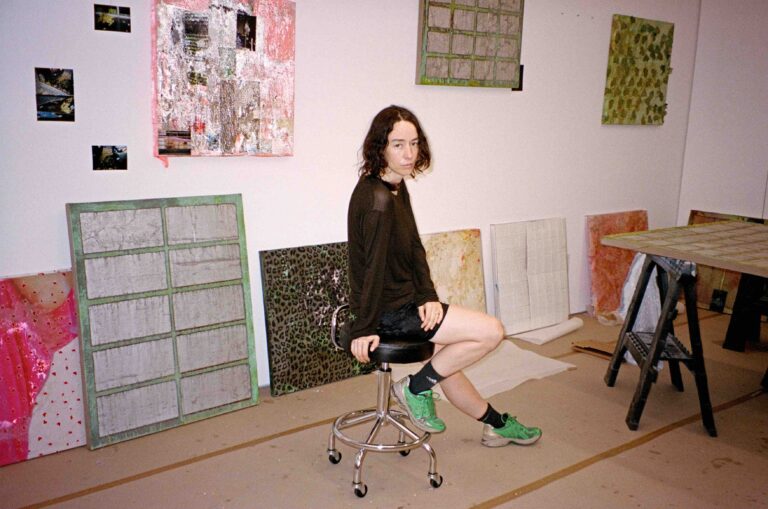


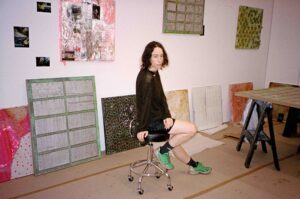



 in your life?
in your life?